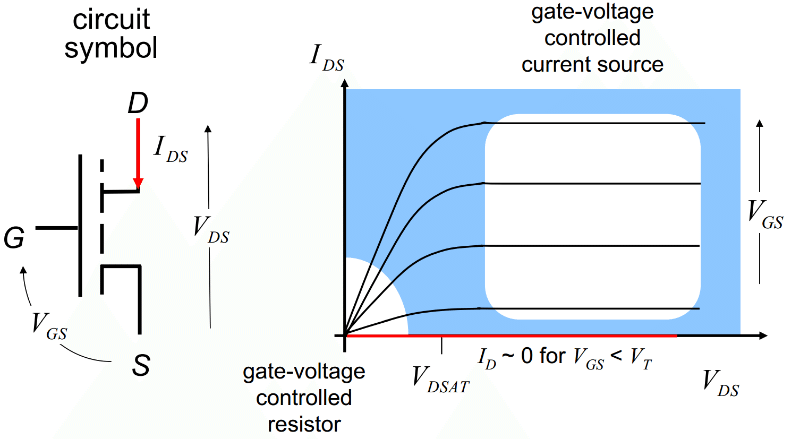Output characteristics of an n-channel MOSFET 
Theory
Introduction
The output characteristics of an n-channel Metal-Oxide-Semiconductor Field-Effect Transistor (MOSFET) describe how the drain current (ID) varies as a function of the drain-to-source voltage (VDS) for different gate-to-source voltage (VG) levels. These characteristics are essential for understanding the behavior of MOSFETs in electronic circuits, especially in applications such as amplification, switching, and digital logic.

Fig. 1. Ideal I-V output characteristics of an nMOS transistor
MOSFET Regions of Operation
The output characteristics of an n-channel MOSFET can be divided into three distinct regions of operation, based on the applied voltages:
Cutoff Region: When the gate-to-source voltage (VG) is below the threshold voltage (VT), there is no conductive channel formed between the drain and source. As a result, the drain current (ID) is approximately zero, and the MOSFET remains in the "OFF" state.
Linear (Ohmic) Region: When VG exceeds VT and VDS is relatively small, the MOSFET operates in the linear or ohmic region. In this region, the conductive channel is established, and the drain current increases approximately linearly with VDS. The MOSFET behaves like a variable resistor, where the channel resistance decreases with an increase in VG. The drain current in the linear region is given by the equation:
ID = K[( VG - VT)VDS - (VDS)2/2],
where K is the process transconductance parameter.
Saturation Region: As VDS increases and becomes larger than (VG - VT), the MOSFET enters the saturation region. In this region, the drain current becomes nearly constant for a given VG and is no longer sensitive to changes in VDS. The MOSFET behaves as a current source, and the drain current is primarily controlled by the gate voltage. The expression for ID in the saturation region is given by:
ID = (1/2)K( VG - VT)2.
Threshold Voltage (VT)
The threshold voltage (VT) is a key parameter in MOSFET operation. It is the minimum gate-to-source voltage required to create a conductive channel between the drain and source. When VG is less than VT, the MOSFET remains in the cutoff region, and the drain current is nearly zero. For VG values above VT, the channel becomes conductive, allowing current to flow.
Significance of the Output Characteristics
The output characteristics provide valuable information about the MOSFET's behavior across different regions of operation. By analyzing the ID vs. VDS curves for various VG values, one can understand the device's switching capabilities, transconductance, and resistance in the linear region. This analysis is crucial for designing MOSFET-based circuits, such as analog amplifiers and digital switches.
